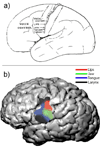Speech map in the human ventral sensory-motor cortex
- PMID: 24492080
- PMCID: PMC3913904
- DOI: 10.1016/j.conb.2013.08.015
Speech map in the human ventral sensory-motor cortex
Abstract
The study of spatial maps of the ventral sensory-motor cortex (vSMC) dates back to the earliest cortical stimulation studies. This review surveys a number of recent and historical reports of the features and function of spatial maps within vSMC towards the human behavior of speaking. Representations of the vocal tract, like other body parts, are arranged in a somatotopic fashion within ventral SMC. This region has unique features and connectivity that may give insight into its specialized function in speech production. New methods allow us to probe further into the functional role of this organization by studying the spatial dynamics of vSMC during natural speaking in humans.
Copyright © 2013 Elsevier Ltd. All rights reserved.
Figures


Similar articles
-
A probabilistic map of the human ventral sensorimotor cortex using electrical stimulation.J Neurosurg. 2015 Aug;123(2):340-9. doi: 10.3171/2014.11.JNS14889. Epub 2015 May 15. J Neurosurg. 2015. PMID: 25978714
-
Structural Organization of the Laryngeal Motor Cortical Network and Its Implication for Evolution of Speech Production.J Neurosci. 2016 Apr 13;36(15):4170-81. doi: 10.1523/JNEUROSCI.3914-15.2016. J Neurosci. 2016. PMID: 27076417 Free PMC article.
-
Laminar analysis of excitatory local circuits in vibrissal motor and sensory cortical areas.PLoS Biol. 2011 Jan 4;9(1):e1000572. doi: 10.1371/journal.pbio.1000572. PLoS Biol. 2011. PMID: 21245906 Free PMC article.
-
Motor maps and the cortical control of movement.Curr Opin Neurobiol. 2014 Feb;24(1):88-94. doi: 10.1016/j.conb.2013.08.018. Epub 2013 Sep 21. Curr Opin Neurobiol. 2014. PMID: 24492084 Review.
-
Parietofrontal circuits for action and space perception in the macaque monkey.Neuroimage. 2001 Jul;14(1 Pt 2):S27-32. doi: 10.1006/nimg.2001.0835. Neuroimage. 2001. PMID: 11373129 Review.
Cited by
-
Paroxysmal epileptic laryngospasms: Frequent nightly awakenings.Neurol Clin Pract. 2018 Dec;8(6):e46-e48. doi: 10.1212/CPJ.0000000000000554. Neurol Clin Pract. 2018. PMID: 30588390 Free PMC article. No abstract available.
-
Mapping Human Laryngeal Motor Cortex during Vocalization.Cereb Cortex. 2020 Nov 3;30(12):6254-6269. doi: 10.1093/cercor/bhaa182. Cereb Cortex. 2020. PMID: 32728706 Free PMC article.
-
Slow Firing Single Units Are Essential for Optimal Decoding of Silent Speech.Front Hum Neurosci. 2022 Aug 3;16:874199. doi: 10.3389/fnhum.2022.874199. eCollection 2022. Front Hum Neurosci. 2022. PMID: 35992944 Free PMC article.
-
Enhanced structural connectivity within the motor loop in professional boxers prior to a match.Sci Rep. 2021 Apr 27;11(1):9015. doi: 10.1038/s41598-021-88368-4. Sci Rep. 2021. PMID: 33907206 Free PMC article.
-
Transcranial direct current stimulation over left inferior frontal cortex improves speech fluency in adults who stutter.Brain. 2018 Apr 1;141(4):1161-1171. doi: 10.1093/brain/awy011. Brain. 2018. PMID: 29394325 Free PMC article. Clinical Trial.
References
-
- Kent Ray D. The uniqueness of speech among motor systems. Clinical linguistics & phonetics. 2004;18.6-8:495–505. - PubMed
-
- Penfield Wilder, Roberts Lamar. Speech and brain-mechanisms. Princeton: Princeton University Press; 1959.
-
- Foerster Otfrid, Penfield Wilder. The structural basis of traumatic epilepsy and results of radical operation. Brain. 1930;53.2:99–119.
-
-
Penfield Wilder, Boldrey Edwin. Somatic motor and sensory representation in the cerebral cortex of man as studied by electrical stimulation. Brain: A journal of neurology. 1937 To this day, one of the best descriptions of cortical stimulation in humans. Describes the somatotopy of speech articulators, phonation, sensory-motor division, and much more. Many questions raised here are still unanswered.
-
-
- Beevor Charles E, Horsley Victor. A record of the results obtained by electrical excitation of the so-called motor cortex and internal capsule in an orang-outang (Simia satyrus) Philosophical Transactions of the Royal Society of London. B. 1890;181:129–158.
Publication types
MeSH terms
Grants and funding
LinkOut - more resources
Full Text Sources
Other Literature Sources

